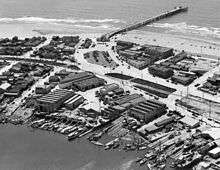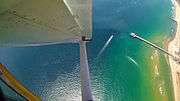Newport Pier
The Newport Pier is one of two municipal piers located within the city of Newport Beach, California, at the center of the Balboa Peninsula. It is 1,032 feet (314.6 m) long. The pier replaced the McFadden Wharf (1888-1939) and the site is registered as California Historical Landmark number 794.[1]

History

The original pier was known as McFadden Wharf when it was completed in the summer of 1888 by local landowners James and Robert McFadden.[1] The wharf served as a shipping connection for the McFaddens to offload lumber, hides and other merchandise.[2] In 1890, they connected it to the Santa Ana and Newport Railway for commercial transport into Orange, San Bernardino, and Riverside Counties.[1] The McFaddens sold the site in 1902 to W.S. Collins, who began to transform the area for residential and recreational use.[3] The expansion of the Los Angeles passenger railway system to the wharf in 1905 catalyzed the development of the city of Newport Beach as a tourist destination.[3][4]
In 1922, the pier was remodeled by the City of Newport and remained a shipping terminus until 1939 when it was destroyed in a hurricane.[2]
Newport Municipal Pier
The current pier was reconstructed on the same site in 1940.[2] Located at Oceanfront Boulevard and 21st Place, it is popular for angling, strolling and dining. At the end of the pier sits a restaurant called the "Newport Pier Grill and Sushi." The restaurant has an outdoor patio called the William Wright Terrace, which adds 288 square feet (26.8 m2) and can seat up to 28 with a view of the water. The Newport Pier Grill and Sushi has been closed since 2012. At the base of the pier is the Dory Fishing Fleet, a beachside fishing cooperative founded in 1891. Also at the base of the pier is the headquarters of the city fire department's Lifeguard division.
It serves as the base for Newport Beach Junior Lifeguards, a program run by the fire department that allows for kids to receive basic water training.
References
- "Orange: NO. 794 McFadden Wharf". Office of Historic Preservation. State of California. 2015. Retrieved 6 May 2015.
- Staff (July 1981). "Past: Wave Goodbye to Beach Pleasures". Orange Coast Magazine: 87–89.
- Schwieterman, Joseph P. (2004). "Newport Beach, California (70,032)". When the Railroad Leaves Town: American Communities in the Age of Rail Line Abandonment. 2. Truman State Univ Press. pp. 60–61. ISBN 9781931112147.
- Staff (May 12, 2015). "A look at the trains that built the O.C. coast". Los Angeles Times. Retrieved 12 January 2016.
 Postcard of the Newport Municipal Pier
Postcard of the Newport Municipal Pier Life Guard Headquarters
Life Guard Headquarters Life Guard Headquarters
Life Guard Headquarters Newport Pier Grill and Sushi, Newport Beach, CA
Newport Pier Grill and Sushi, Newport Beach, CA Dory Fleet, Newport Beach, CA
Dory Fleet, Newport Beach, CA Newport Beach Pier Aerial
Newport Beach Pier Aerial Newport Beach Pier
Newport Beach Pier